After three consecutive weeks in which I discussed dark matter, it is time to vary subjects a little and move on with something different. Please don’t worry if you are a big fan of dark stuff, I will come back to dark matter sooner or later.
A couple of years ago, I started to get interested in the phenomenology associated with neutrinos. These interests gave rise to two scientific publications in 2021, another one being in the pipeline for 2022. However, I won’t discuss those publications today. Although they are definitely worth a full post (at least from my own perspective, which is disputable of course), they require some prerequisites on which I have not written yet. The present blog is thus dedicated to filling this gap, including basic facts about neutrinos.
I explain below how current knowledge about neutrinos has been built over the years, and why we can consider that neutrinos belong to the darkest parts of the Standard Model. As it is now a kind of tradition for my blogs, anyone pushed for time could get the bulk of the information shared today in the last few paragraphs of the blog. As usual, feel free to ask anything in the comments section, to which I will try to answer in the best possible manner.
For those interested in starting with a question, there is a strong link between the futuristic image below (that is not futuristic at all by the way) and neutrinos. Can you guess what it is?
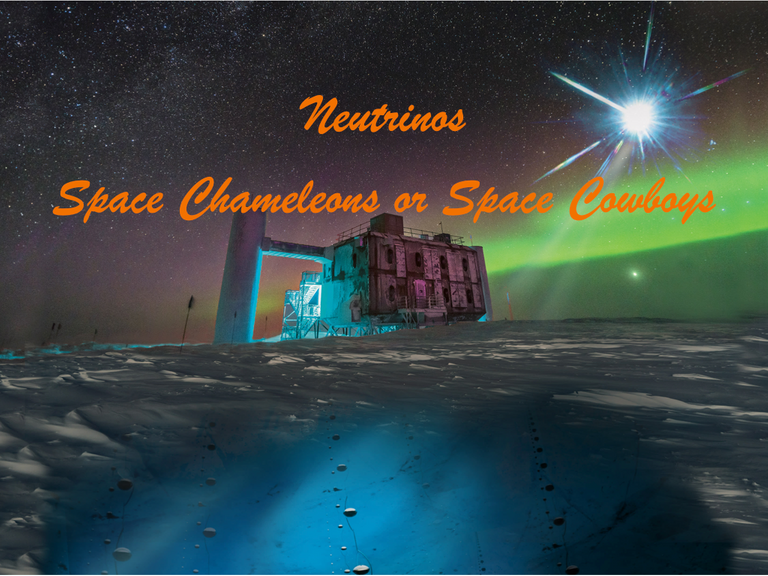
[Credits: Original image from IceCube (NSF)]
A particule that cannot be detected…
The neutrino story starts in the first half of the 20th century, when physicists of that time were trying to understand how beta decays were working. Beta decays are processes in which a given atomic nucleus decays into another atomic nucleus together with the emission of an electron.
In order to understand the dynamics of such processes, there are two golden rules of physics that need to be stated. The first one is that energy is conserved in any process. This rule was already discussed quite a bit in the previous blog, as it is the one on which we rely to reconstruct a potential signal of dark matter at particle colliders like the Large Hadron Collider at CERN.
In addition, there is another important conservation rule that needs to be introduced: electric charge conservation. This means that in a reaction the sum of the electric charges of the interacting bodies must be equal to the sum of the electric charges of the produced bodies.
Recalling that an atomic nucleus comprises protons (of a positive electric charge of +1 unit) and neutrons (of a zero electric charge), any atomic nucleus has a positive electric charge equal to its number of constituting protons. We are now ready to go back to the process of interest in which one atomic nucleus transforms into another plus an electron. In order to balance the created negative electric charge of the electron, the initial-state atomic nucleus must have one fewer proton than the final-state nucleus.
In other words, a beta decay is a process in which one atomic nucleus comprising some neutrons and protons decays into another nucleus comprising of one more proton and one fewer neutron, and an electron. As one beautiful image is better than many words and as I have zero artistic skills (special thanks to @robotics101 for reminding this to me), I am afraid that the only image illustrating this will be the one provided below (my poor readers…).
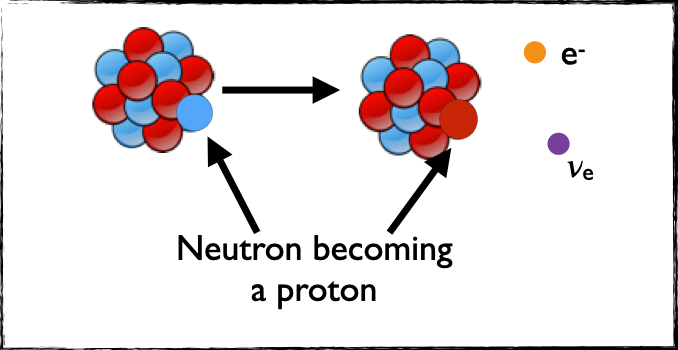
[Credits: @lemouth (and his ‘super’ artistic powers)]
Here, we can see that there is an atomic nucleus on the left that decays into another atomic nucleus (shown in the right part of the figure). Both nuclei are made of protons (red circles) and neutrons (blue circles), and one neutron is converted into one proton in the decay process. This comes together with the emission of an electron (the orange circle). Let’s ignore for now the purple particle (i.e. the neutrino), as in the first half of the20th century such a particle did not exist.
In such a process the electric charge is conserved: one neutron of charge zero is transformed into one proton of charge +1 and one electron of charge -1. However, the energy has to be conserved too. Doing the math (and using Einstein’s theory of special relativity), it turns out that the energy of the electron is fully determined to be equal to a given value.
Experimentally, this was however not the case. It was observed that the energy of the electron could take any value between zero and the expected value. To find an explanation to this problem, ‘Pauli did a terrible thing’ (using his own words, as shown here): he postulated that an invisible particle that could not be detected was emitted together with the electron. Energy conservation was restored as this particle was then sharing the available energy with the electron.
Fermi theorised the concept shortly after Pauli’s proposal, and Reines and Cowan demonstrated the whole thing experimentally in 1956. They relied on 400 litres of water containing cadmium chloride, and a bunch of electronic devices observing the water tank. From there, they waited for a neutrino to collide with a proton in the water to produce a positron and a neutron (a kind of inverse process as the beta decay process).
After having observed a few events, Reines and Cowan upgraded the neutrino from its status of being an imaginative object to a status of being an existing particle.
From one to three neutrinos
Fast forward from the 1950s to today, we know that there are three species of neutrinos: the electron neutrino (the one involved in beta decay processes), as well as the muon neutrino and the tau neutrino. They are moreover all very weakly interacting, so that thousands of billions of neutrinos flow through any human body every second, without leaving in there any track.
The existence of the muon neutrino was hypothetised soon after the discovery of the muon (the big fat brother of the electron) from the study of cosmic rays, as detailed in this earlier blog. In trying to understand how the weak force worked, physicists were conducted to postulate the existence of a second neutrino. The reason is that particles should be organised in pairs from the perspective of the weak force (up and down quarks, strange and charm quarks, electrons and electron neutrinos, etc.).
The experimental confirmation of the existence of the muon neutrino involved the production of the first beam of neutrinos ever. This beam was prepared by firing accelerated protons onto a fixed target. The particles produced in that reaction were then flying further away, over tens of metres, before decaying. The associated decay products were finally stopped by a 13.5-metre-thick wall of steel.
Were all produced particles stopped by the wall? Of course not! All neutrinos produced in the reaction survived, by virtue of their very-weakly-interacting nature. The whole apparatus hence resulted in a pure beam of neutrinos starting right after our wall of steel.
Physicists could in this way build a detector on the other side of the wall to study phenomena originating from the interactions of the neutrino beam. They adopted the choice of constructing a 10-ton spark chamber. Why such a huge detector? Well, neutrinos being interacting very rarely, large detectors are in order to maximise the chance to see some events.
A few events were eventually observed in this detector, and those events were compatible with the fact that the Standard Model (of that time) should include two species of neutrinos: the electron neutrino and the muon neutrino.
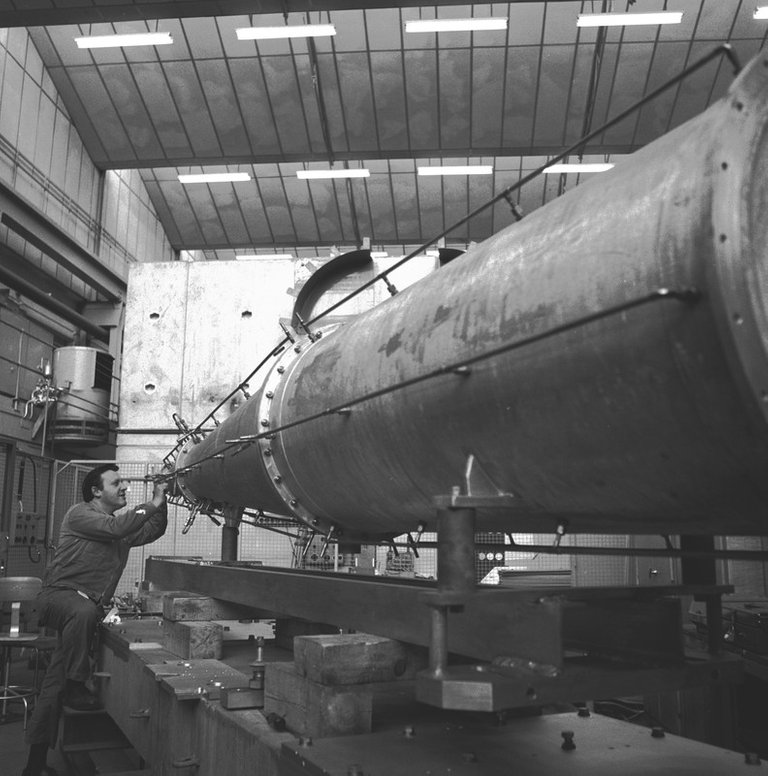
[Credits: CERN (CC-BY-4.0)]
In their hunt for new particles, physicists discovered the tau lepton in the 1970s. They observed 64 events resulting from a collision process in which one electron and one positron collided and generated one electron, one muon and some missing energy (once again, this comes from energy conservation).
In order to understand how such events could arise, it was required to postulate the existence of a new lepton, the tau lepton. In the process considered, tau leptons were pair produced in electron-positron collisions. Tau leptons being unstable, one of the two produced taus decayed into an electron (together with missing energy carried away by neutrinos), and the other one in a muon (also together with missing energy carried away by neutrinos). Among all produced neutrinos (there are four of them), two were tau neutrinos.
Tau neutrinos were however much tougher to find and detect directly. In the above process, we only observe missing energy, and it is impossible to tell which fraction of the missing energy is attached to which invisible particle. Only the sum of all invisible contributions is detected.
We hence had to wait… until July 2000 to discover the tau neutrino (see here). I was born for already many years, and I even started to be seriously interested in particle physics at that time (for those interested in my life, I was studying something a bit different in the early 2000s).
The DONUT collaboration investigated the interaction of an intense beam of neutrinos with a detector, and expected to observe the collision of some tau neutrinos from the beam with the iron atoms making a 15-metre-long detector.
After three years of hard work, they observed 12 events in which one out of the trillion of tau neutrinos of the beam reacted with an iron nucleus. This observation was made possible as the detector comprised an alternance of iron plates and photographic emulsions. The studied process led the generation of a tau lepton that resulted in a 1-millimetre-long observable track. Understanding what happened in the emulsions is what took three years.
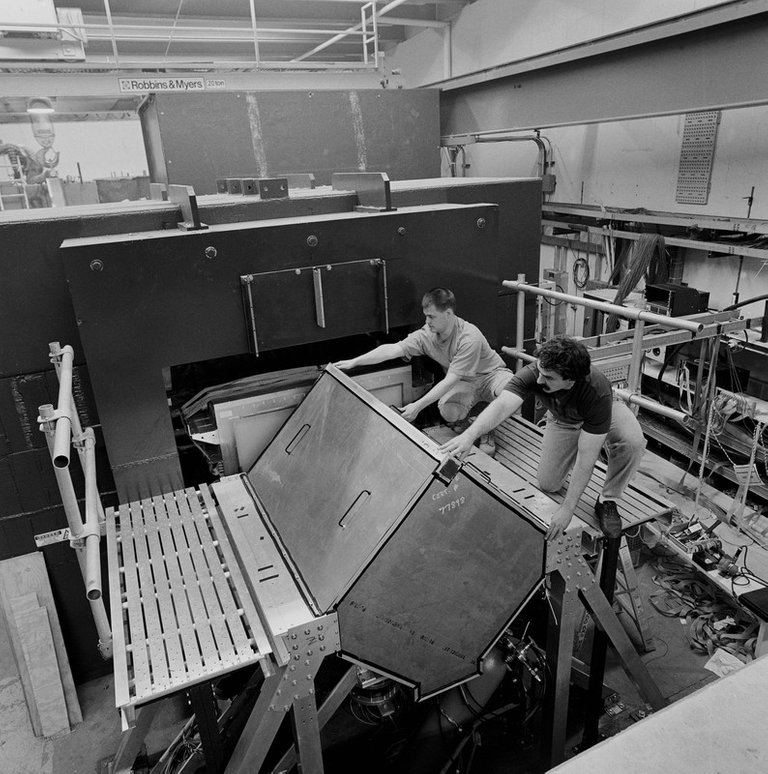
[Credits: Fermilab]
Neutrinos as chameleons!
Let’s summarise where we stand so far. The Standard Model contains three species of neutrinos (the electron neutrino 𝞶e, the muon neutrino 𝞶𝝁 and the tau neutrino 𝞶𝜏). All these three neutrinos have been experimentally confirmed, as discussed in the previous paragraphs. In order to incorporate neutrinos with right properties in the Standard Model (i.e. relative to observations), all neutrinos have to be massless.
While this is not a problem stricto sensu, there were important issues with neutrino phenomena, some of them dating back from the 1960s. For instance, the amount of electron neutrinos created in all nuclear reactions happening inside our Sun appeared to be incorrect. When burning its fuel, the Sun indeed emits a large amount of neutrinos that we can observe on Earth. However, it turns out that two thirds of these solar neutrinos were reported missing.
One of the suggestions to solve this puzzle was that neutrinos of a given species could change nature within their propagation. A significant fraction of the electron neutrinos produced inside the Sun would hence be converted to muon and tau neutrinos during their 150-million-kilometre journey to Earth.
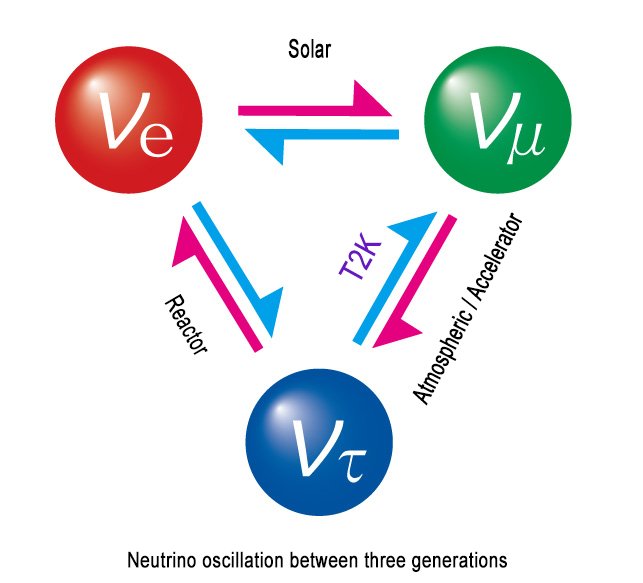
[Credits: J-Parc]
In addition, the relative amount of muon and electron neutrinos produced in the atmosphere through cosmic ray interactions was measured to a value non-consistent with the Standard Model. As another example, we can also mention issues with neutrino fluxes emerging from accelerators. And so on… However, all those problems could be solved at once by assuming that neutrinos could change nature during the course of their propagation.
The puzzle was finally solved thanks to the hard work around two key experiments, at Super-Kamiokande (Super-K) and at the Sudbury Neutrino Observatory (SNO). This work led to the Nobel prize in physics in 2015 (see here).
Super-K was a tank of 50,000 tons of extremely pure water surrounded by 11,000 light detectors. I remind that neutrinos are very weakly interacting, so that huge detectors are in order to maximise the chances to detect rare associated events. While most neutrinos pass through the tank without doing anything, once in a while a neutrino hits an atom in the water, leading to the creation of either an electron (if we have an electron neutrino) or a muon (if we have a muon neutrino).
SNO worked in a similar way, relying on a tank of 1,000 tons of heavy water and about 10,000 light detectors located around the tank. To get an idea about what it looks like, please have a look to the picture below. Whereas the first experiment studied atmospheric neutrinos the latter focused on solar neutrinos. The conclusions of both experiments were very solid: neutrinos oscillate during their propagation. In other words, they change nature during their journey (in space or in media).
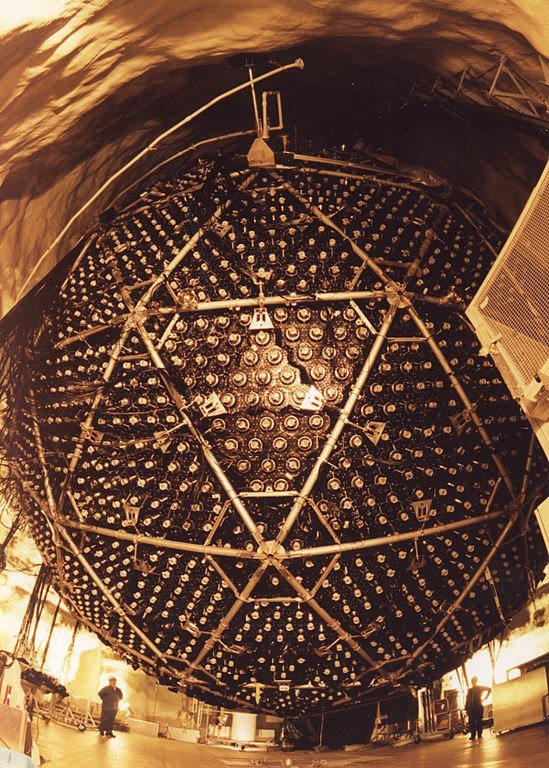
[Credits: SNO (CC BY-SA 4.0)]
The above fact is not a real problem in the sense that quantum mechanics allows for it. However, this is only possible if neutrinos are massive, which they are not in the Standard Model. Neutrino masses being a fact, we have thus a contradiction with the Standard Model. Neutrinos are thus one of the best motivations calling for an extension of the Standard Model of particle physics, as already discussed in this earlier blog.
A good way to describe neutrino physics in a manner agnostic to the new phenomena giving rise to the neutrino masses (as we have a plethora of potential model candidates) is to consider a story in which there are three neutrinos different from the Standard Model neutrinos. Here, they are all admixtures of the electron, muon and tau neutrinos of the Standard Model. Each of these neutrinos has a mass, and contains a given amount of each neutrino flavours (a neutrino can be of an electron, a muon or a tau flavour).
It is then up to experiments to measure the neutrino masses and the so-called mixing parameters dictating the flavour content of each neutrino. There are 6 of those parameters, and while some of them start to be measured quite decently, some others are still quite unconstrained. Therefore, neutrino mass models are still living in a grey zone in terms of theory possibilities (and we should not underestimate theorists’ imagination). The experimental constraints are indeed somewhat constraining, but not too drastically. Precision must still come, and it will come!
The mysteries of neutrino physics in a TLDR way
Neutrinos are probably the most interesting beasts of the Standard Model of particle physics. They were postulated initially by Pauli in the 1930s, and considered as a ‘terrible thing’ allowing for an explanation of missing energy signals seen in early radioactivity studies. From that moment, a long journey has been undertaken (and is actually still ongoing).
The Standard Model of particle physics is known to include three species of massless neutrinos, namely the electron neutrino, the muon neutrino and the tau neutrino. The experimental discovery of each of these particles took some time, the tau neutrino having been directly observed only in July 2000. Whilst this was a great success, this came with a lot of intriguing observations.
It indeed appeared that when they undertake long-distance travels, neutrinos of a given (electron, muon or tau) nature can ‘oscillate’ (or be converted) into neutrinos of a different nature. Such a mechanism is quantum mechanically possible, but it requires the three neutrinos to be massive. This is where we have a strong contradiction with the Standard Model. Neutrinos are therefore one of the best portals to physics and new phenomena beyond the Standard Model of particle physics.
As a consequence of neutrino oscillations, each of the three neutrinos is considered as an admixture of the electron neutrino, muon neutrino and tau neutrino of the Standard Model. Equivalently, this means that, each of the three ‘neutrino flavours’ is included by some amount into each of the three neutrinos. The precise measurement of the related parameters is one of the future challenge of all neutrino experiments.
Personally, I started to be interested in such a physics a couple of years ago, and I investigated to which extent the Large Hadron Collider at CERN could help us to unravel a bit the neutrino mysteries. I have proposed, with collaborators, a new handle on the neutrino mixing parameters by means of specific collider probes that have not been considered up to now. This is however the topic of my next blog, hopefully next week.
In the meantime, I wish everybody a nice week, and feel free to abuse of the comment section of this post for questions. Cheers!






